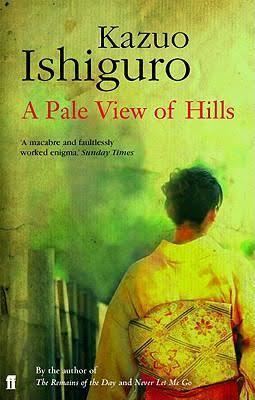7.4 /10 1 Votes7.4
Language English Originally published February 1982 Country United Kingdom | 3.7/5 Goodreads Publication date February 1982 Publisher Faber and Faber OCLC 8303689 | |||||||||||||||||||||||||||||||||
 | ||||||||||||||||||||||||||||||||||
Pages 192 pp (hardback first edition) ISBN 0-571-11866-6 (hardback first edition) Similar Kazuo Ishiguro books, Novels | ||||||||||||||||||||||||||||||||||
Hank weighter on kazuo ishiguro s a pale view of hills
A Pale View of Hills (1982) is the first novel by author Kazuo Ishiguro. It won the 1982 Winifred Holtby Memorial Prize. He received a £1000 advance from publishers Faber and Faber for the novel after a meeting with Robert McCrum, the fiction editor.
Contents
- Hank weighter on kazuo ishiguro s a pale view of hills
- A pale view of hills by prof yinghuei chen
- Plot summary
- Characters
- References
A Pale View of Hills is the story of Etsuko, a middle-aged Japanese woman living alone in England, and opens with discussion between Etsuko and her younger daughter, Niki, about the recent suicide of Etsuko's older daughter, Keiko.
A pale view of hills by prof yinghuei chen
Plot summary
During a visit from her daughter, Niki, Etsuko reflects on her own life as a young woman in Japan, and how she left that country to live in England. As she describes it, she and her Japanese husband, Jiro, had a daughter together, and a few years later Etsuko met a British man and moved with him to England. She took her elder daughter, Keiko, to England to live with her and the new husband. When Etsuko and her new husband have a daughter, Etsuko wants to call her something "modern" and her husband wants an Eastern-sounding name, so they compromise with the name "Niki," which seems to Etsuko to be perfectly British, but sounds to her husband at least slightly Japanese.
In England, Keiko becomes increasingly solitary and antisocial. Etsuko recalls how, as Keiko grew older, she would lock herself in her room and emerge only to pick up the dinner-plate that her mother would leave for her in the kitchen. This disturbing behavior ends, as the reader already has learned, in Keiko's suicide. "Your father," Etsuko tells Niki, "was rather idealistic at times...[H]e really believed we could give her a happy life over here... But you see, Niki, I knew all along. I knew all along she wouldn't be happy over here."
Etsuko tells her daughter, Niki, that she had a friend in Japan named Sachiko. Sachiko had a daughter named Mariko, a girl whom Etsuko's memory paints as exceptionally solitary and antisocial. Sachiko, Etsuko recalls, had planned to take Mariko to America with an American soldier identified only as "Frank." Clearly, Sachiko's story bears striking similarities to Etsuko's.
